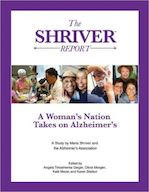The Shriver Report: A Woman’s Nation Takes on Alzheimer’s
A Woman’s Nation Takes on Alzheimer’s describes an epidemic of huge proportions for which American women, government, business and families are ill-prepared. Our leaders—and all Americans—need to know the facts.
Most everyone knows something about Alzheimer’s. Or knows someone with the disease. Alzheimer’s is quickly taking center stage—hundreds of clinical trials are under way, hundreds of Alzheimer research papers are being published every year, and media coverage occurs almost daily. But what most Americans don’t realize—and what this ground-breaking report makes clear—is that women are at the epicenter of Alzheimer’s disease.
Never before has a report made such a compelling connection between Alzheimer’s disease and women. Sixty-five percent of all those with Alzheimer’s are women. Sixty percent of caregivers for persons with Alzheimer’s are women. That’s 3.3 million American women with Alzheimer’s and another 6.7 million women providing care for a friend or loved one. If you consider by mid-century that as many as 8 million women will have Alzheimer’s disease, it’s clear a huge Alzheimer tsunami is coming at this nation’s women. This report is for you.
Why this report?
A Woman‘s Nation Takes on Alzheimer’s sounds the alarm for Americans—women, men, government leaders, corporations, nonprofits, churches and the press—to understand that almost a third of Americans have a family member with Alzheimer’s and that women are effectively a gender under siege by this disease.Other reports on Alzheimer’s exist. But this one—backed by an extensive, scientific poll, buttressed by indepth chapters by experts and salted with dozens of poignant, revealing essays and original photography commissioned exclusively for this report—is the first to underscore the impact of the disease on women and how that impact is compounded by the increased risk women have of developing the disease.
What does it show?
The numbers the report reveals are shocking:
- 10 million women either have Alzheimer’s or are caring for someone with it.
- Women constitute about two-thirds of those who suffer from Alzheimer’s and also about 60 percent of the caregivers for those who have it.
- A third of women caregivers are caring 24/7 for a person with Alzheimer’s. Nearly 40 percent say they had no choice in becoming a caregiver.
- The societal impact of Alzheimer’s disease—on government, families and business—totals about $300 billion per year.
- Almost two-thirds of all working caregivers report having to go to work late, leave early or take time off to provide care. Yet they get less support for elder care than they do for child care. So it’s not surprising that nearly half of all women caregivers report high emotional and physical stress.
- Last year, The Shriver Report: A Woman’s Nation Changes Everything revealed a major tipping point: Working women emerged as primary breadwinners for millions of households as their presence grew to comprise fully half of all workers. This new report makes it clear that women are in the midst of an even more far-reaching transformation in which they work, raise kids, care for the elderly, drive consumer decisions and may suffer emotional and physical stress because of it all.
The impact of Alzheimer’s is stunning on a broader scale as well. The economic cost, as the report shows, is now about $300 billion a year and could triple in coming decades. As Maria Shriver points out, with 78 million baby boomers now moving into their later years, the cost of Alzheimer’s to American society is expected to be $20 trillion between now and 2050. And while annual per-patient costs of Alzheimer’s is $56,800, the lion’s share of these costs, 60 percent, is borne by families.
What needs to be done?
While there’s hope and while many researchers are working together feverishly, there’s yet no cure or prevention for Alzheimer’s. A great deal of fear exists among rank-and-file Americans about developing the disease, and a strong sense pervades the public that not enough scientific progress is being made. Compared to how much progress people believe is being made in heart disease, cancer, diabetes and strokes, Americans rank Alzheimer’s dead last. So, while there’s a lot being done in clinics, research labs and the media to bring Alzheimer’s from the shadows to the news, what is not being done is—or should be—making changing the trajectory of Alzheimer’s disease a true national priority
Government, business and the citizens themselves must prepare for a future in which Alzheimer’s looms larger in American life. Among the key questions that need to be asked and answered:
- How do we get to an appropriate level of public research funding for Alzheimer’s, given its high prevalence and cost, both of which are expected to soar?
- Is there a way to reduce the financial impact of the disease on families and society?
- How can we help millions of women caught between the dual demands of work and providing for a friend or relative with Alzheimer’s?
- How can average Americans prepare for the very real possibility of Alzheimer’s crashing into their lives? Nearly three-quarters (72 percent) say they haven’t considered their care options.
- How can government, business, nonprofits and the press effectively call attention to the threat and implement solutions?
- In short, as a society we need to do a much better job of keeping pace with the stark realities of Alzheimer’s, especially the reality of the besieged American woman who is raising our next generation while caring for our last.

